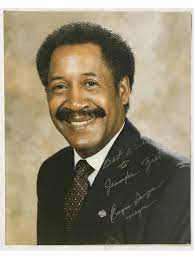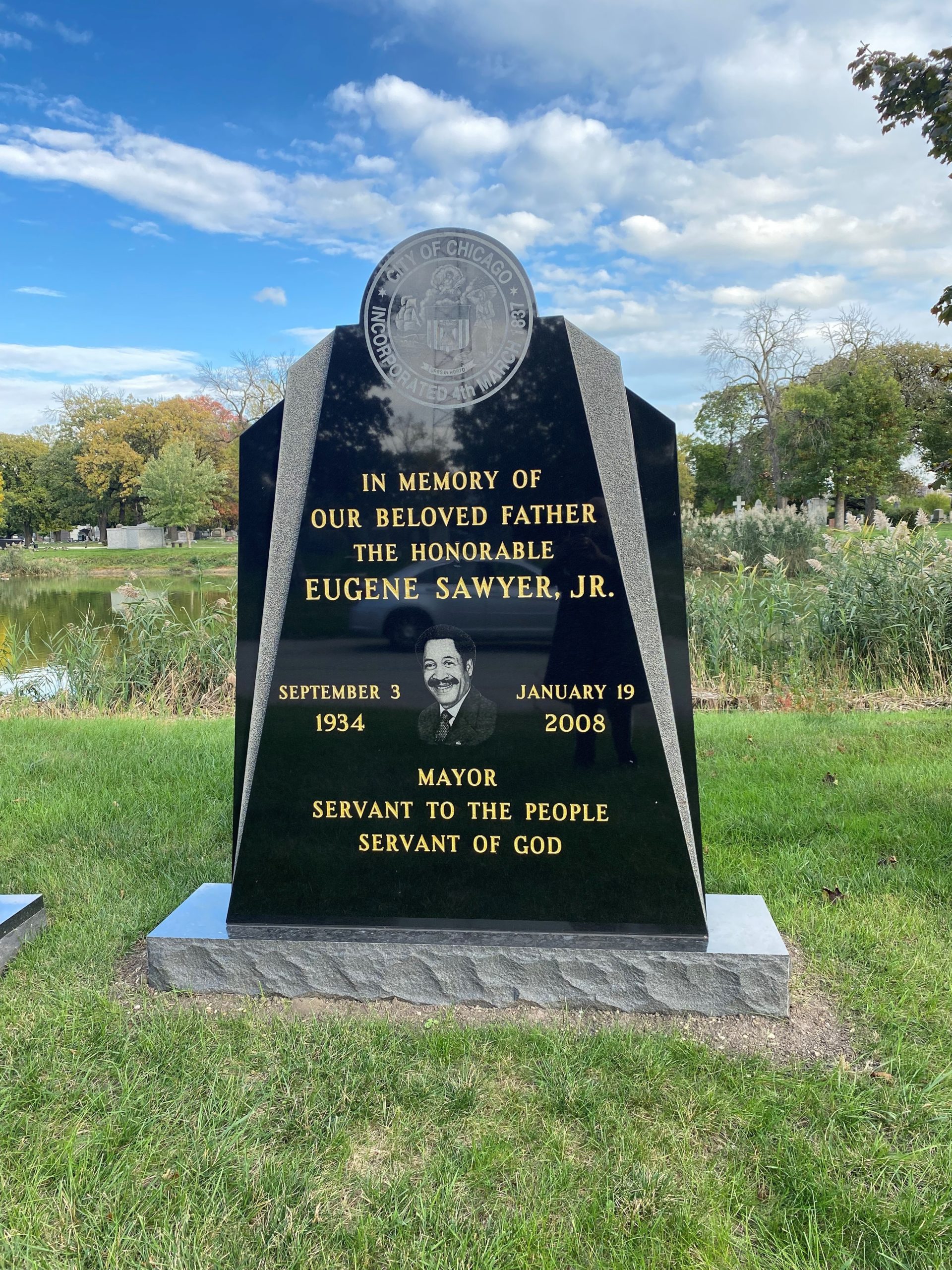He was Chicago’s second Black mayor who died years after guiding the city through a tumultuous period following the death of the city’s first Black Mayor Harold Washington. When he died in 2008, Mayor Eugene Sawyer followed the footsteps of his predecessor and was buried at Oak Woods Cemetery.
But unlike Washington, for whom an impressive mausoleum was built shortly after his death, for nearly 13 years Sawyer was buried in an unmarked grave at Oak Woods, the final resting place of many of Chicago’s Black elite, including entertainers, politicians, journalists and athletes.
Recently a huge, impressive black marble slab etched with Mayor Sawyer’s image was placed on his grave, ending years of obscurity for a forgotten public figure who for so long lay six feet under in a cemetery often visited by tourists and historical groups.
Sawyer’s grave is in the southwest corner of the cemetery, where he is buried near the edge of a scenic man-made lake. The newly laid headstone is four feet wide and over seven feet tall. Made of black marble, the words etched in gold leaf read, “IN MEMORY OF OUR BELOVED FATHER, THE HONORABLE MAYOR EUGENE SAWYER, JR.” An etched image of a smiling Sawyer sits in the center of the headstone above the words, “MAYOR, SERVANT TO THE PEOPLE, SERVANT OF GOD.” A City of Chicago seal sits atop the headstone.
On the other side of the pond is the marked grave and private mausoleum of Mayor Washington, who died in 1987 after suffering a massive heart attack. Following Mayor Washington’s death, Sawyer served as Chicago’s interim mayor for 16 months from 1987 to 1989 before he was defeated by Richard M. Daley in the Democratic Primary.
Before he was mayor, Sawyer was then the longest-serving Black alderman in his lifetime, having served the 6th Ward for 16 years before becoming mayor of Chicago. His son Alderman Roderick Sawyer now serves the 6th Ward, following in his father’s footsteps.

Mayor Sawyer died on January 19, 2008. On the 11th anniversary of his death, the Crusader published a story reporting that Sawyer, despite his stature as a notable public official, was buried in an unmarked grave, causing visitors to search in vain for his final resting place at Oak Woods Cemetery.
Now adorned with its massive headstone, Mayor Sawyer’s grave is easy to find as it towers over other markers in that section of the cemetery.
Alderman Sawyer did not respond to an email requesting comment on the grave’s enhancement by Crusader press time Wednesday, October 27, for its print edition. A staff member at Oak Woods Cemetery said Mayor Sawyer’s headstone was installed about a month ago but gave few details.
Mayor Sawyer was born in 1934 in Greensboro, Alabama, historically a small Black town with a population of just over 2,000 people. He was the son of a mortician and attended segregated schools in Alabama.
After moving to Chicago in 1957, Sawyer was hired as an industrial waste coordinator for the city’s sewer department. That same year, Sawyer joined the Democratic Ward Organization of the 6th Ward, where he worked his way up through the organization’s ranks.
Through the years, Sawyer served as president of the 6th Ward Young Democrats and financial secretary for the entire ward organization.
In 1971, Sawyer was elected alderman of the 6th Ward, replacing incumbent A.A. “Sammy” Rayner, Jr., who retired after serving one, four-year term.
Throughout his life, Sawyer was known as a calm, soft-spoken public figure. When Washington died in 1987, Sawyer became embroiled in a bitter battle with then-4th Ward Alderman Timothy Evans, to replace Washington. Blacks in Chicago at the time felt that the city’s highest position should go to a Black person. With then-Cook County State’s Attorney Richard M. Daley as an opponent, progressive Blacks were concerned that the city would return to the days of Chicago’s old political machine that was fueled by Daley’s father, Mayor Richard J. Daley.
In the Black community, the battle over who would represent the city’s people of color was brewing between Sawyer and Evans. Evans, who was Washington’s protégé, chairman of the Chicago Finance Committee and floor leader of the City Council, proclaimed himself Washington’s rightful heir.
Many Black aldermen favored Evans. Reverend Jesse Jackson decided to endorse Sawyer. Fearing a split Black vote, Evans decided to run as an independent of his newly created Harold Washington Party. Jackson later called on Blacks to support Evans during the general election in April 1989, should Sawyer lose to Daley in the Democratic primary.
The feud between the two heated up on December 2, 1987, after the City Council voted 29-19 to elect Sawyer as interim mayor over Evans, at 4 a.m. in City Hall. Most of the votes came from white aldermen who often opposed Washington during his terms in office. On December 1, 1987—the night before—about 5,000 of Evans’ supporters stormed City Hall to attend the meeting, which didn’t start until four hours later, according to news reports. Many stood outside, chanting, “We want Evans” and “No more deals.” After Sawyer was elected interim mayor, many Blacks accused him of being a “sell-out” to the white political establishment. His election threw grease on the fire during the special mayoral election in 1989, where there was concern that two Blacks in the race would lead to the election of Richard M. Daley. Black leaders had called for a summit to support Evans.
Daley defeated the interim Mayor Sawyer, capturing at least 57 percent of the vote to Sawyer’s 42 percent.
After his defeat, Mayor Sawyer retreated from public life. He died at Adventist Hinsdale Hospital on January 19, 2008. He was 73. His death came one day after Cook County Board President John Stroger died at 79.
In 2016, the city renamed the South Water Purification Plant after Sawyer, to the Eugene Sawyer Water Purification Plant. Mayor Rahm Emanuel and Alderman Roderick Sawyer attended the festivities. In a story in dnainfo.com—a now-defunct online publication—Alderman Roderick Sawyer said he was unsure why it had taken the city so long to name anything after his father.






